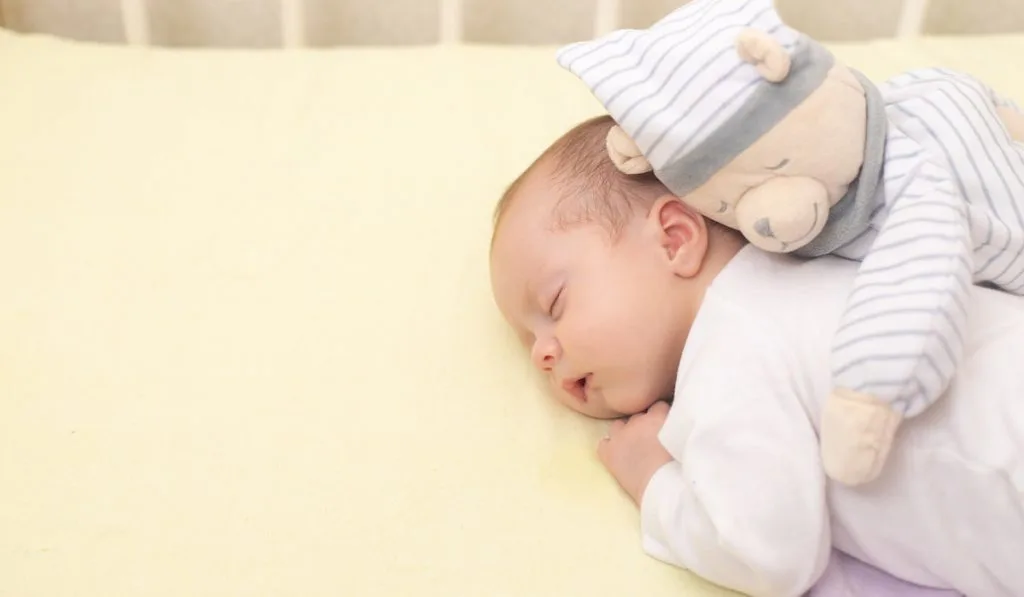It’s the joy of every parent when their child starts to stand. This is until they begin to do so in their cribs when they are supposed to be sleeping. On average, babies are supposed to begin standing on their own at around eight months, with the adventurous ones starting at six months.
As exciting as standing is to the baby, the nap regression can be frustrating to a parent. This is especially true if your child used to be a perfect napper.
But before you go in and repeatedly try to lay them down, you must first understand why babies stand in their cribs.

Why Does My Baby Stand in Their Crib?
A baby may be standing in the crib because:
- They are excited about their newly acquired talent
- They are teething
- Changes in sleeping patterns have occurred
Newly Acquired Talent
Babies learn how to stand first before they know how to get back down, so patience is crucial as you teach them how to get down.
Since it is a newly acquired talent, babies tend to practice this skill during their nap time. This is because the ambiance is perfect with no distractions, just them and their strong little legs.
Unfortunately, first trials will cause frustration. Even though the child can easily stand, getting down might not be easy. As the time awake becomes longer, they become tired and frustrated with the standing position. This eventually leads to him sinking down into a sleeping position.
Once your baby starts to stand, they are transitioning to walking and running. However, such a stage can be very challenging for both parties as the baby starts to act independently.
Teething
If your child can stand and sit without any problem but still constantly stands in the crib during the night, they could be unwell. One of the most common reasons for such behavior is teething frustration. You need to check their gums to see whether they are swollen, or observe if your child is trying to scratch their gums.
Finding the cause of your baby standing ensures you get to tackle the situation effectively. If you don’t understand the reason behind such behavior, make sure you visit a child sleep consultant and get to understand all the answers related to your baby’s sleep.

What to Do
There are some easy things that you can do to help get your child into a healthy sleeping pattern.
With the right amount of dedication and patience on your part, you should be able to get your baby back to sleeping well in their crib in a few nights.
Use a dim nightlight
Avoid turning on the lights at all times during the evening, and consider using a dim nightlight during the first few nights.
The goal is not to allow your child to become too stimulated during the evening and night.
Establish trust
Always hold your child throughout the day for at least one hour. This will help to lay down a foundation of trust between you and your baby.
Pay attention to their body language when they seem overstimulated or tired so that you know when it is time to calm them down.
Keep a comfortable room temperature
Keep your baby’s room at a comfortable temperature throughout the day and night.
Avoid overstimulation by not allowing them to sleep or play with their favorite blanket or stuffed animal during this time.
Offer enough practice time
During the child’s non-sleep times, ensure they get enough time to practice the skills of standing and getting back down.
You can achieve this by standing your baby against a sofa or couch. Then place a toy next to them on the ground. Help them reach the toy by bending their knees.
Just like practicing baby squats, the baby will quickly adapt within no time. Due to the exercise, the child will fall asleep as soon as he is put in bed.
Do not let your child fall asleep with any sort of toy or device that will stimulate them.
Adjust the Naptime
Scheduling your baby’s naptime to 30 minutes earlier will work like magic. Even if the baby is perfecting his standing skills in common areas during the day, he will still find it novel to continue practicing the skills in his crib.
Early naptime will give your child enough time to practice before he can sleep on time.
Sleep Training
Sleep training approaches should be implemented once you are completely satisfied that your toddler can get down on his own. This helps in breaking any sleep habits. However, this will include adjusting your old habits to match your now growing child.
- Start by laying the child down sporadically and not constantly. This should be done after every 8 to 10 minutes. Such a strategy will allow your child to have more space to figure out by himself without skipping naps.
- Other standard sleep training methods include the Ferber and Sleep lady methods. Both of these methods will, however, involve crying. But you have to remember; the objective is to get your child’s sleeping routine back. It’s also apparent the child will not be crying due to pain but because he just wants more playtime and attention.
- Sleep Lady method entails sitting on a chair near the kid’s crib until the toddler falls asleep. On the other hand, the Ferber approach doesn’t require you to be in your child’s room at all times. All you need to do is keep checking the baby periodically and the baby will know you still care but don’t go near them.

Key Takeaway
The objective of sleep training is not to become a pacifier’s alternative. Of course, there will always be enough opportunity to soothe your child. But it shouldn’t be physical contact, especially if everything seems ok.
Resist any urge of moving in to help your child lie down. This will prolong their return to the standard period as he will see it as a fun activity. Remember, babies are naturally intelligent and fully comprehend effects and causes.
Nothing compares to the joy of being a parent and seeing your kids grow. However, parenthood can also be a challenge. Going through the different phases of early childhood, starting with teething, sleep regressions, colic, among other stages, will be stressful to both the child and parent.
Every new skill is an excellent achievement in a child’s life. But at times, such milestones will be overwhelming.
It is a natural and normal phase for a baby to stand in a crib not sleeping, but with patience, both of you can easily conquer it if you put the tips mentioned above into action. Showing care and love during this challenging phase in your child’s life can hasten the process.
If the situation doesn’t change, consider visiting a pediatrician.
